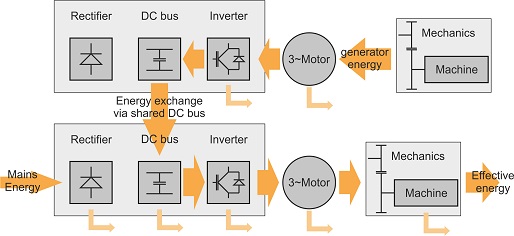Planning of Energy-Efficient Trajectories with Utilization of Energy Storage and Energy Interchange between Electrical Drives

| Team: | Dipl.-Ing. Christian Hansen |
| Year: | 2010 |
| Funding: | German Research Foundation (DFG) |
| Is Finished: | yes |
In general, electrical drives can work both as a generator and as a motor. In multiple-axis applications (e.g. industrial robots, storage and retrieval machines etc.), the direct current links of the utilized frequency converters can be connected for energy interchange between different electrical drives. To achieve the full potential of energy efficiency enhancement for desired motions, it is essential to consider energy interchange as well as temporary energy storage at the trajectory planning phase.
Additionally, such applications include the possibility to also consider the states of potential and kinetic energy of single axes of the system. For instance, the potential energy of a mechanical system can be employed for the initiation of a movement. Accordingly, the kinetic energy is converted back to potential energy in the final phase of the movement and can be stored for subsequent motions. The challenge is to minimize the energy demand for arbitrary movements of multiple-axis applications by dexterous utilization of existing mechanical or electrical energy storages in the drive system.
